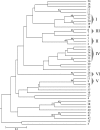Multiple-locus variable-number tandem-repeat analysis of the swine dysentery pathogen, Brachyspira hyodysenteriae
- PMID: 20554811
- PMCID: PMC2916602
- DOI: 10.1128/JCM.00348-10
Multiple-locus variable-number tandem-repeat analysis of the swine dysentery pathogen, Brachyspira hyodysenteriae
Abstract
The spirochete Brachyspira hyodysenteriae is the causative agent of swine dysentery, a severe colonic infection of pigs that has a considerable economic impact in many swine-producing countries. In spite of its importance, knowledge about the global epidemiology and population structure of B. hyodysenteriae is limited. Progress in this area has been hampered by the lack of a low-cost, portable, and discriminatory method for strain typing. The aim of the current study was to develop and test a multiple-locus variable-number tandem-repeat analysis (MLVA) method that could be used in basic veterinary diagnostic microbiology laboratories equipped with PCR technology or in more advanced laboratories with access to capillary electrophoresis. Based on eight loci, and when performed on isolates from different farms in different countries, as well as type and reference strains, the MLVA technique developed was highly discriminatory (Hunter and Gaston discriminatory index, 0.938 [95% confidence interval, 0.9175 to 0.9584]) while retaining a high phylogenetic value. Using the technique, the species was shown to be diverse (44 MLVA types from 172 isolates and strains), although isolates were stable in herds over time. The population structure appeared to be clonal. The finding of B. hyodysenteriae MLVA type 3 in piggeries in three European countries, as well as other, related, strains in different countries, suggests that spreading of the pathogen via carrier pigs is likely. MLVA overcame drawbacks associated with previous typing techniques for B. hyodysenteriae and was a powerful method for epidemiologic and population structure studies on this important pathogenic spirochete.
Figures


Similar articles
-
Understanding the molecular epidemiology and global relationships of Brachyspira hyodysenteriae from swine herds in the United States: a multi-locus sequence typing approach.PLoS One. 2014 Sep 5;9(9):e107176. doi: 10.1371/journal.pone.0107176. eCollection 2014. PLoS One. 2014. PMID: 25192199 Free PMC article.
-
Characterization of Brachyspira hyodysenteriae isolates from Italy by multilocus sequence typing and multiple locus variable number tandem repeat analysis.J Appl Microbiol. 2017 Aug;123(2):340-351. doi: 10.1111/jam.13492. Epub 2017 Jul 12. J Appl Microbiol. 2017. PMID: 28510989
-
The role of transportation in the spread of Brachyspira hyodysenteriae in fattening farms.BMC Vet Res. 2018 Jan 10;14(1):10. doi: 10.1186/s12917-017-1328-5. BMC Vet Res. 2018. PMID: 29321027 Free PMC article.
-
A review of methods used for studying the molecular epidemiology of Brachyspira hyodysenteriae.Vet Microbiol. 2017 Aug;207:181-194. doi: 10.1016/j.vetmic.2017.06.011. Epub 2017 Jun 19. Vet Microbiol. 2017. PMID: 28757022 Review.
-
Swine dysentery: aetiology, pathogenicity, determinants of transmission and the fight against the disease.Int J Environ Res Public Health. 2013 May 10;10(5):1927-47. doi: 10.3390/ijerph10051927. Int J Environ Res Public Health. 2013. PMID: 23665849 Free PMC article. Review.
Cited by
-
Multilocus variable-number-tandem-repeats analysis (MLVA) distinguishes a clonal complex of Clavibacter michiganensis subsp. michiganensis strains isolated from recent outbreaks of bacterial wilt and canker in Belgium.BMC Microbiol. 2013 Jun 5;13:126. doi: 10.1186/1471-2180-13-126. BMC Microbiol. 2013. PMID: 23738754 Free PMC article.
-
Understanding the molecular epidemiology and global relationships of Brachyspira hyodysenteriae from swine herds in the United States: a multi-locus sequence typing approach.PLoS One. 2014 Sep 5;9(9):e107176. doi: 10.1371/journal.pone.0107176. eCollection 2014. PLoS One. 2014. PMID: 25192199 Free PMC article.
-
Dissemination of clonal groups of Brachyspira hyodysenteriae amongst pig farms in Spain, and their relationships to isolates from other countries.PLoS One. 2012;7(6):e39082. doi: 10.1371/journal.pone.0039082. Epub 2012 Jun 19. PLoS One. 2012. PMID: 22723934 Free PMC article.
-
In vitro evaluation of gentamicin activity against Spanish field isolates of Brachyspira hyodysenteriae.Porcine Health Manag. 2022 Dec 1;8(1):48. doi: 10.1186/s40813-022-00291-w. Porcine Health Manag. 2022. PMID: 36451249 Free PMC article.
-
Trends towards lower antimicrobial susceptibility and characterization of acquired resistance among clinical isolates of Brachyspira hyodysenteriae in Spain.Antimicrob Agents Chemother. 2011 Jul;55(7):3330-7. doi: 10.1128/AAC.01749-10. Epub 2011 May 9. Antimicrob Agents Chemother. 2011. PMID: 21555771 Free PMC article.
References
-
- Al Dahouk, S., P. Le Flèche, K. Nöckler, I. Jacques, M. Grayon, H. C. Scholz, H. Tomaso, G. Vergnaud, and H. Neubauer. 2007. Evaluation of Brucella MLVA typing for human brucellosis. J. Microbiol. Methods 69:137-145. - PubMed
-
- Bellgard, M. I., P. Wanchanthuek, T. La, K. Ryan, P. Moolhuijzen, Z. Albertyn, B. Shaban, Y. Motro, D. S. Dunn, D. Schibeci, A. Hunter, R. Barrero, N. D. Phillips, and D. J. Hampson. 2009. Genome sequence of the pathogenic intestinal spirochete Brachyspira hyodysenteriae reveals adaptations to its lifestyle in the porcine large intestine. PLoS One 4:e4641. - PMC - PubMed
Publication types
MeSH terms
LinkOut - more resources
Full Text Sources
Other Literature Sources
Molecular Biology Databases

